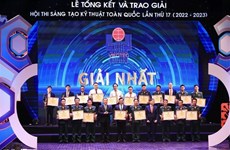VN, Russia ink agreement on nuclear fuel rods
Vietnam and Russia have signed an inter-governmental agreement on
transporting highly enriched uranium fuel rods used by Da Lat nuclear
reactor into Russia.
Vietnam and Russia have signed an inter-governmental agreement on
transporting highly enriched uranium fuel rods used by Da Lat nuclear
reactor into Russia.
The agreement was signed in Hanoi on March 16 by Deputy Minister of Science and Technology Le Dinh Tien and Deputy Director General Nikolay Spasskiy of the Rosatom Nuclear Energy Corporation.
Addressing the signing ceremony, Minister of Science and Education Nguyen Quan and Deputy Director General Nikolay Spasskiy said this is an important event reflecting Vietnam’s commitment in implementing the joint Statement of the first Nuclear Security Summit in Washington in 2010 and the Seoul Nuclear Security Summit this year.
Together with the agreement on building the proposed Ninh Thuan 1 nuclear power plant and the Nuclear Science and Technology Centre, this agreement has reaffirmed the strategic cooperation between Vietnam and Russia in using atomic energy for peaceful purposes and ensuring security and safety and nonproliferation of nuclear weapons, they said.
These agreements will facilitate Russia’s assistance and cooperation with Vietnam in building and developing the latter’s young nuclear energy sector as well as its implementation of commitments to ensuring security and safety and non-proliferation of nuclear weapons, the minister said.
Since 2007, Vietnam has involved in the programme to change fuel used by Da Lat reactor from highly enriched uranium (HEU) to lowly enriched uranium (LEU). The programme was jointly initiated by the International Atomic Energy Agency (IAEA), the US and Russia to manage HEU fuel used in research reactors manufactured by the US and Russia to prevent the use of this source of fuel for non-peaceful purposes.
In Sept. 2007, Vietnam transported 35 unused HEU fuel rods of Da Lat reactor to Russia and received 36 new LEU fuel rods made by Russia.
In Dec. 2010, Vietnam received and transported 66 LEU fuel rods to Da Lat reactor to replace all HEU fuel rods being used. In 2011, Da Lat reactor successfully started its operation with LEU fuel.
Used HEU fuel rods are expected to be transported to Russia in May, 2013.-VNA
The agreement was signed in Hanoi on March 16 by Deputy Minister of Science and Technology Le Dinh Tien and Deputy Director General Nikolay Spasskiy of the Rosatom Nuclear Energy Corporation.
Addressing the signing ceremony, Minister of Science and Education Nguyen Quan and Deputy Director General Nikolay Spasskiy said this is an important event reflecting Vietnam’s commitment in implementing the joint Statement of the first Nuclear Security Summit in Washington in 2010 and the Seoul Nuclear Security Summit this year.
Together with the agreement on building the proposed Ninh Thuan 1 nuclear power plant and the Nuclear Science and Technology Centre, this agreement has reaffirmed the strategic cooperation between Vietnam and Russia in using atomic energy for peaceful purposes and ensuring security and safety and nonproliferation of nuclear weapons, they said.
These agreements will facilitate Russia’s assistance and cooperation with Vietnam in building and developing the latter’s young nuclear energy sector as well as its implementation of commitments to ensuring security and safety and non-proliferation of nuclear weapons, the minister said.
Since 2007, Vietnam has involved in the programme to change fuel used by Da Lat reactor from highly enriched uranium (HEU) to lowly enriched uranium (LEU). The programme was jointly initiated by the International Atomic Energy Agency (IAEA), the US and Russia to manage HEU fuel used in research reactors manufactured by the US and Russia to prevent the use of this source of fuel for non-peaceful purposes.
In Sept. 2007, Vietnam transported 35 unused HEU fuel rods of Da Lat reactor to Russia and received 36 new LEU fuel rods made by Russia.
In Dec. 2010, Vietnam received and transported 66 LEU fuel rods to Da Lat reactor to replace all HEU fuel rods being used. In 2011, Da Lat reactor successfully started its operation with LEU fuel.
Used HEU fuel rods are expected to be transported to Russia in May, 2013.-VNA












